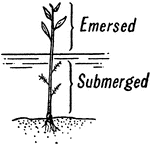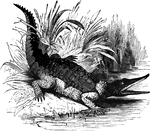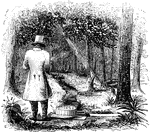
Salt-water terrapin
The salt-water terrapin lives in salt or brackish water along the sea-coast, buying itself in the mud…

Wood-terrapin
Sometimes referred to as the fresh-water terrapin, the wood-terrapin ranges from Canada to Pennsylvania.
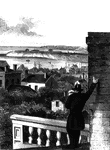
Oswego Harbor
View of Oswego Harbor, 1848. This view is from the top of the United States Hotel, looking east-northeast.…

Wolffiella
Plants floating just below water surfacel plant body made up of a clump of short filaments.
Compo
Distant view of Compo. This view is from the top of a high hill northeast of the dwelling of Mr. Ebenezer…

Arnold's residence
Arnold's residence. Arnold lived in Water Street, near the ship-yard. The house is still standing (1848),…
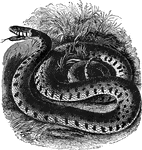
Common ring-snake
"The common snake of Europe... frequents woods, bogs, and other sheltered situations in the vicinity…

Form of the embryo
"Figure 2 gives an outline of its form; the arrows at the side of the head show the currents of water…

Boston
"View of Boston from Dorchester Heights in 1774. This picture is from an English print of the time.…

Floating Battery
"American Floating Battery. I am indebted to the kindness of Peter Force, Esq., of Washington city (editor…
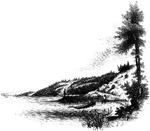
Williams landing-place
"Landing-place of Roger Williams. This view is on the left bank of the Seekonk, looking south. The point…

Gaspee Point
"Gaspee Point. This view is from the bank of the cove just below the Point, looking northeast, showing…
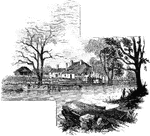
Greene and Knox Head-Quarters
"Head-quarters of Greene and Knox. This view is from the turnpike road, looking southeast. The water…
Peekskill Landing
"View from Peekskill Landing. This view is from Peekskill landing, looking up the river. On the left…
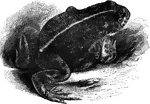
Natter-jack toad
"Resembles the common toad of Europe in appearance: there are also other foreign species, among which…

Surinam toad
"At the breeding season the back of the female exhbits a number of small pits; into these pits the male…
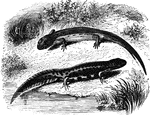
Salamanders
"The Land Salamanders, unlike the Tritons, are ovo-viparous, though the young at first inhabit the water…

Siren lacretina
"Two feet long, black above and dusky beneath. It is of an eel-like form, lives in the muddy water of…
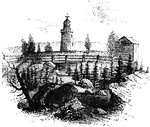
Stony Point
"Rear view at Stony Point. This sketch presents a rear view of the old embankments of the fort, and…
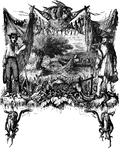
Pisces
"A fish may be defined as a Vertibrate animal breathing through the medium of water, by means of branchiae,…
Large Spotted Dogfish
"Two to three feet long, haunts deep water, and feeds on small fish and crustacea. Found on the British…

Pennat's Globefish
"Is found in Europe; it occasionally happens that this, as well as other species, when they have puffed…

Red Gurnard
"Twelve to sixteen inches long; it feeds on curstaceous animals; spawns in May or June; it is esteemed…

River Bullhead
"Four to five inches long; hides in the water among loose stones, feeds on the larvae of water-insects,…
Stickleback
"Three inches long, is found in both salt and fresh water. It so abounds in the sluggish steams and…

Fifteen-Spined Stickleback
"Five to eight inches long. It is very voracious, and one six inches long being put into a pail of water…
Great Weaver
"It is about twelve inches long, lives in deep water, and is noted for inflicting serious wounds with…

Gilt-Head
"Twelve inches long, abundant in the Mediterranean, and found on the coasts of Africa and Europe, from…
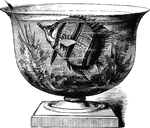
Copperband Butterflyfish
"It feeds upon insects, and is remarkable for its method of procuring them. When it observes a fly,…
Shanny
"A very curious species, five sinches long, remarkable for creeping out of the water with their pectoral…

Angler
"The fishing frog is three to five feet long. It has an enormous mouth, armed with numerous pointed…

Saury Pike
"From one to two feet long, swims in vast shoals, and when chased by the porpoise leaps to the height…

Common Cod
"It is two to four feet long, and weighs from two to seventy spounds; the general color is greenish…
Pollack
"A frolicsome fish, constantly splashing in the water, ad biting keenly at the hood; it is twelve to…

Common Sole
"Ten to twenty inches long, and weighing from on to ten pounds; it inhabits sandy shores in deep water,…

Torn Rock
"Torn Rock. This view is from the verge of the dam above the Ramapo works, near the rail-way, looking…
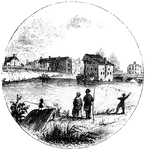
Trenton
"Trenton Bridge and vicinity. This view is from the north side of the Assanpink, a few rods above the…

Tench
"Found in most Europes lakes in rivers. It is exceedingly tenacious of life; loves foul and weedy water;…
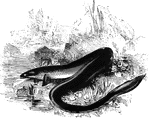
Common European Eel
"These have an elongated form, and a soft, thick, slimy skin; the scales are very minute, and imbedded…
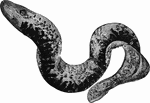
European lamprey
"The color is yellowish marked with brown. Like the sharks and rays is it without an air bladder; to…

Myxine
"The body is long and eel-like, and the skeleton is reduced to a mere cartilaginous tube. It ours out…
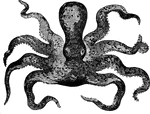
Cuttlefish
"The cuttlefishes have a strange method of walking, head-downward, on their outspread arms; they can…

Jamestown Island
"Distant view of Jamestown Island. This view is from the north side of what was once a marsh, but now…
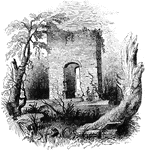
Jamestown Ruins
"Ruins at Jamestown. This view is from the old church-yard, looking toward James River, a glimpse of…
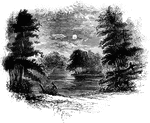
Trading Ford
"Trading Ford. This view of the Trading Ford, where greene, with Morgan and his light troops, crossed…

Carinaria
"The Carinaria has an elongated transparent body, dotted with elevated points, and furnished toward…
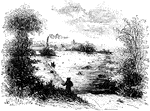
Cherokee Ford
"View at the Cherokee Ford. This view is from the east bank of the river. Toward the extreme right is…

Sander's Creek
"View at Sander's Creek. This view is from the north side of the Creek. like the other stream, it is…

Fort Watson
"Site of Fort Watson."—Lossing, 1851 The Siege of Fort Watson was an American Revolutionary War confrontation…
!["View from the site of Fort Cornwallis. Fort Cornwallis occupied the ground in the rear of the Episcopal church, now a grave-yard. This view is from within the inclosure, looking northeast, and includes a portion of Schultz's bridge, the Savannah River, and Hamburg upon the opposite bank. In the foreground is seen portions of the church-yard wall, and upon the brink of the river below are [African Americans] employed in placing bales of cotton upon the wharves for transportation to the sea-coast. The wharves are two stories in height, one to be used at low water, the other when the river is 'up.' There were remains of the ditch and embankments of the fort within the grave-yard when I was there; and the trench leading to the water-gate, where the 'Pride-of-India tree is seen, was very visible."—Lossing, 1851](https://etc.usf.edu/clipart/14100/14143/ft-cornwalli_14143_mth.gif)
Fort Cornwallis
"View from the site of Fort Cornwallis. Fort Cornwallis occupied the ground in the rear of the Episcopal…

Orontium
Plants smaller; not wite-powdery above; leaves shed water easily; flowers along fleshy spike enclosed…
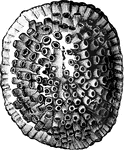
Tube of the water-pot shell magnified
"The animal in this case is inclosed in a cacareous tube, the anterior extremity of which is closed…

Passenger Train
"The first passenger locomotive built in the United States. A year after the Enterprise sailed for India,…

